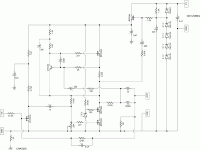I have just read through the "cascoding" of Passlabs. I understand the cascoding is to get the ideally flat collector (drain) curves, and accordingly to improve the resulting technical characters.
What about the resulting sound? Is the sound of amplifiers also improved effectively in certain cases?
JH
What about the resulting sound? Is the sound of amplifiers also improved effectively in certain cases?
JH
Stefanobilliani, thanks for the feedback and the link to Mr. Pass' previous post. I think you have me straightened out and I have modified my schematic to incorporate his and your suggestions, i.e. removed the cascode from the input and added the resistor vetween the V+ rail and the Zener so current will actually flow across it to set the voltage.
But as a DIY newbie (at least with amps) I am still a little uncertain about the exact implementation. Is the value of that resistor relatively important? If my basic understanding is correct, the resistance across the Zener will be high resulting in a relatively small current flow across the Zener from the V+ rail, and will be largely unaffected by the value of the resistor, however, I am concerned about current flow to the gate of the transistor, so I have set the resistor value high to minimize this. Is my thinking correct?
But as a DIY newbie (at least with amps) I am still a little uncertain about the exact implementation. Is the value of that resistor relatively important? If my basic understanding is correct, the resistance across the Zener will be high resulting in a relatively small current flow across the Zener from the V+ rail, and will be largely unaffected by the value of the resistor, however, I am concerned about current flow to the gate of the transistor, so I have set the resistor value high to minimize this. Is my thinking correct?
Attachments
I believe your thinking is quite reasonable.
Anyhow, the cascoding would narrower the output voltage swing amplitude. It still has a value for the sound? I am intersted in the cascoding and so asking...
JH
Anyhow, the cascoding would narrower the output voltage swing amplitude. It still has a value for the sound? I am intersted in the cascoding and so asking...
JH
One interesting trick (from TubeCad.com, I think Jan 2000) would be to use an "ultralinear cascode" where some of the output is fed back to the gate of the cascode fet. You get lower distortion (due to feedback...you can do a similar thing feed-forward but this would require additional changes to the frontend) and higher swing. You can piggyback the signal that the tracking regulator is getting. You need to be worried about DC bias points, but that should be fairly straightforward.
-Won
-Won
- Status
- Not open for further replies.
